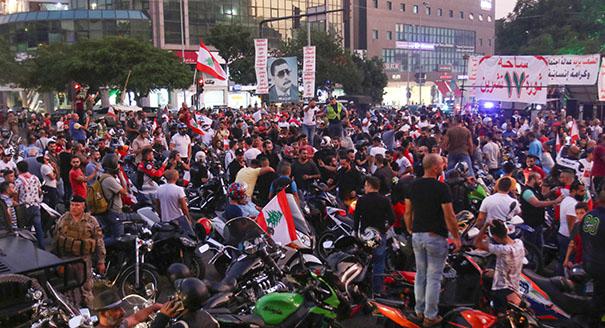As Lebanon’s economic crisis has worsened, with no solution in sight and little but further collapse and poverty on the horizon, the protest movement in Sidon that emerged in October 2019 has kept up its actions. It has done so despite the movement’s loss of momentum in other parts of the country, and in defiance of attempts to snuff it out.
Sidon has seen a string of marches and gatherings due to the deteriorating economic and social situation, with criticism focusing on Lebanon’s banks, in particular the central bank, and money changers. Protestors have also targeted the Hasbat Saida fruit and vegetable market, where prices have skyrocketed in a way that has not reflected the shift in the Lebanese pound-U.S. dollar exchange rate.
The suicide of ‘Alaa al-Saidawi, a man of 20 who hanged himself in his bedroom, passed largely unnoticed in Sidon, and Lebanon more generally. ‘Alaa committed suicide after losing his job at a restaurant. He was not alone, however, and is one of many people in the city without work because of the economic crisis and the sharp fall in the pound’s value. Another Sidonian also killed himself recently over his financial difficulties. Several others have poured fuel on themselves in public squares in further suicide attempts.
However, this has not stopped the Sidon protest movement. Activists have vowed to carry on despite the circumstances and the fact that attendance at their rallies has subsided due to Covid-19 fears in Lebanon. They have also held new kinds of protests, most of them outside utility companies, such as the electricity and water utilities and the Ogero telecoms company. Recently, people demonstrated outside the municipality building to protest against the fact that Sidon’s trash processing plant, which was set up several years ago to deal with the garbage crisis, has still not opened due to political wrangling. As Sidon doesn’t host ministries or company headquarters like Beirut, most protests have taken place outside the municipality building, the main representative of state authority.
The strange thing is the total lack of media coverage of these manifestations. After television channels covered Sidon intensively at the start of the uprising, particularly during the first three months, they have been totally absent of late. This has pushed many Sidonians to alter their methods. Most protests no longer attract more than a hundred people, down from the more than 1,000 in the early days. The movement now relies, instead, on its Facebook page, Saida Tantafed (Sidon Rises Up), to publish its news and publicize events.
The city’s protest movement passed through several key stages that have defined the course of events. Things took a violent turn when protesters attacked banks for effectively holding their deposits hostage, prompting more violence from the security forces. The first stage came with the bombing of a local branch of Fransabank on April 25 because the banks’ were blocking withdrawals, particularly of U.S. dollars. After a review of CCTV footage, two Saida Tantafed activists, Waddah Ghanwi and Mahmoud Mroueh, were charged with causing the blast.
A second significant stage was the escalation in repression of activists by security forces, to the point of beatings, forced disappearances, and electrocution. Activist ‘Alaa ‘Antar was one of seven young men arrested last April near the municipality building, and tortured for four days. In a video posted online, he told the story of what he and several other detained activists had suffered at the hands of the Lebanese Army. “They started hitting us as soon as we were in the army vans,” he said. “They blindfolded us and kept beating us, then one of the soldiers wet one of my socks and electrocuted me. They beat us like crazy and humiliated us in all kinds of ways.”
The protesters’ defense team said in a statement that many of the detainees “were subjected to intense violence during their arrest, inside [military] vehicles and at Army Intelligence detention centers, according to the testimony of lawyers who interviewed them and of detainees released so far. [This] is intended to extract information and punish the detainees, and could amount to crimes of torture.”
Violence by the security agencies has increased of late, especially since the announcement of Covid-19 lockdown measures. Such practices violate two laws—Law No. 65 of 2017 banning torture and Law No. 105 of 2018 outlawing forced disappearances—as well as international treaties to which Lebanon is a signatory.
Human rights groups have documented attacks and violence by security forces against activists. These appear to reflect a decision at the political level to repress the demonstrations by installing a police state aimed at forestalling any form of change that could threaten the ruling oligarchy. Amnesty International has responded by calling on the Lebanese authorities to take all possible measures to protect peaceful protesters and respect their right to freedom of assembly, including by closing streets and refraining from breaking up peaceful rallies by force.
The protestors in the streets of Sidon have built up their sense of awareness in the months since October 17, 2019, with debate sessions and forums notable for the wide range of participants—including communists, Islamists, Nasserites, and Hariri supporters—who would have never met prior to the uprising. The protesters’ determination is summed up in one phrase often heard in Sidon: “We’re carrying on.”












